

Compact Muon Solenoid
LHC, CERN
| CMS-EXO-16-044 ; CERN-EP-2018-061 | ||
| Search for disappearing tracks as a signature of new long-lived particles in proton-proton collisions at $\sqrt{s} = $ 13 TeV | ||
| CMS Collaboration | ||
| 19 April 2018 | ||
| JHEP 08 (2018) 016 | ||
| Abstract: A search is presented for long-lived charged particles that decay within the CMS detector and produce the signature of a disappearing track. A disappearing track is an isolated track with missing hits in the outer layers of the silicon tracker, little or no energy in associated calorimeter deposits, and no associated hits in the muon detectors. This search uses data collected with the CMS detector in 2015 and 2016 from proton-proton collisions at a center-of-mass energy of 13 TeV at the LHC, corresponding to an integrated luminosity of 38.4 fb$^{-1}$. The results of the search are interpreted in the context of the anomaly-mediated supersymmetry breaking model. The data are consistent with the background-only hypothesis. Limits are set on the product of the cross section for direct production of charginos and their branching fraction to a neutralino and a pion, as a function of the chargino mass and lifetime. At 95% confidence level, charginos with masses below 715 (695) GeV are excluded for a lifetime of 3 (7) ns, as are charginos with lifetimes from 0.5 to 60 ns for a mass of 505 GeV. These are the most stringent limits using a disappearing track signature on this signal model for chargino lifetimes above $ \approx $ 0.7 ns. | ||
| Links: e-print arXiv:1804.07321 [hep-ex] (PDF) ; CDS record ; inSPIRE record ; HepData record ; CADI line (restricted) ; | ||
| Figures & Tables | Summary | Additional Tables | References | CMS Publications |
|---|
| Figures | |
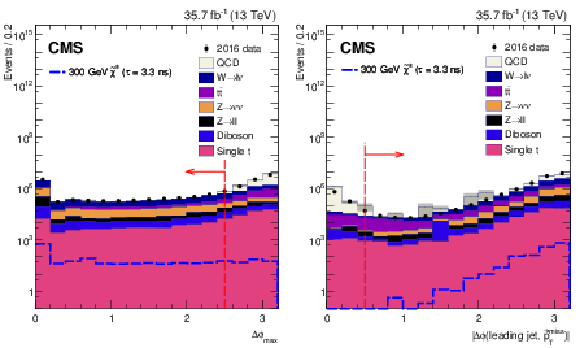
png pdf |
Figure 1:
Distributions of the maximum difference in $\phi $ between any two jets (left) and the difference in $\phi $ between the ${\vec{p}_{\mathrm {T}}}$ of the leading jet and ${\vec{p}_{\mathrm {T}}^{\text {miss}}}$ (right) for events passing the basic selection, before either of the requirements on these two variables is imposed. The data is from the 2016 data-taking period, and the blue dashed lines show the distributions for simulated signal events with a chargino that has a lifetime of 100 cm/$c$ and mass of 300 GeV, with a corresponding production cross section of 0.58 pb. The gray shaded area indicates the statistical uncertainty in the SM background, and the leftmost bin of the left plot includes events with only one selected jet. The vertical dashed lines indicate the chosen value for the requirement on each variable, and the arrows indicate which events are selected. |

png pdf |
Figure 1-a:
Distribution of the maximum difference in $\phi $ between any two jets for events passing the basic selection, before the requirements on this variable is imposed. The data is from the 2016 data-taking period, and the blue dashed lines show the distribution for simulated signal events with a chargino that has a lifetime of 100 cm/$c$ and mass of 300 GeV, with a corresponding production cross section of 0.58 pb. The gray shaded area indicates the statistical uncertainty in the SM background. The leftmost bin includes events with only one selected jet. The vertical dashed line indicates the chosen value for the requirement on the variable, and the arrow indicates which events are selected. |

png pdf |
Figure 1-b:
Distribution of the difference in $\phi $ between the ${\vec{p}_{\mathrm {T}}}$ of the leading jet and ${\vec{p}_{\mathrm {T}}^{\text {miss}}}$ for events passing the basic selection, before the requirements on this variable is imposed. The data is from the 2016 data-taking period, and the blue dashed lines show the distribution for simulated signal events with a chargino that has a lifetime of 100 cm/$c$ and mass of 300 GeV, with a corresponding production cross section of 0.58 pb. The gray shaded area indicates the statistical uncertainty in the SM background. The vertical dashed line indicates the chosen value for the requirement on the variable, and the arrow indicates which events are selected. |
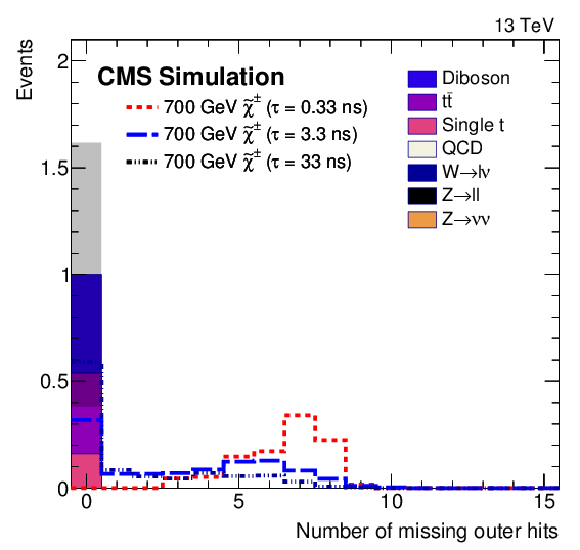
png pdf |
Figure 2:
Distributions of the number of missing outer hits for tracks in simulation that pass the full selection, except for the requirement on that variable. Each signal distribution and the sum of the SM background distributions are scaled to have unit area. The gray shaded area indicates the statistical uncertainty in the SM background. |

png pdf |
Figure 3:
The expected and observed 95% CL upper limits on the product of the cross section for direct production of charginos and their branching fraction to $ {\tilde{\chi}^{0}_{1}} {\pi ^\mathrm {{\pm}}}$ as a function of chargino mass for chargino lifetimes of 10, 100, and 1000 cm/$c$. The direct chargino production cross section includes both $ {\tilde{\chi}^{0}_{1}} {\tilde{\chi}^\pm _{1}} $ and $ {\tilde{\chi}^\pm _{1}} {\tilde{\chi}^\mp _{1}} $ production in roughly a 2:1 ratio for all chargino masses considered. The dashed red line indicates the theoretical prediction for the AMSB model. |
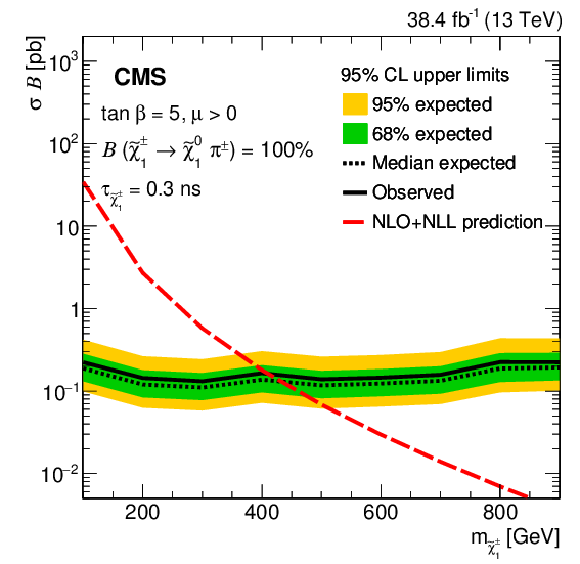
png pdf root |
Figure 3-a:
The expected and observed 95% CL upper limits on the product of the cross section for direct production of charginos and their branching fraction to $ {\tilde{\chi}^{0}_{1}} {\pi ^\mathrm {{\pm}}}$ as a function of chargino mass for chargino lifetime of 10 cm/$c$. The direct chargino production cross section includes both $ {\tilde{\chi}^{0}_{1}} {\tilde{\chi}^\pm _{1}} $ and $ {\tilde{\chi}^\pm _{1}} {\tilde{\chi}^\mp _{1}} $ production in roughly a 2:1 ratio for all chargino masses considered. The dashed red line indicates the theoretical prediction for the AMSB model. |
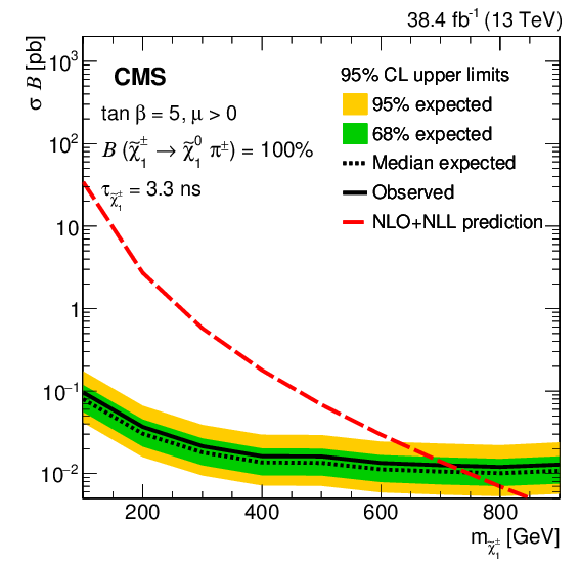
png pdf root |
Figure 3-b:
The expected and observed 95% CL upper limits on the product of the cross section for direct production of charginos and their branching fraction to $ {\tilde{\chi}^{0}_{1}} {\pi ^\mathrm {{\pm}}}$ as a function of chargino mass for chargino lifetime of 100 cm/$c$. The direct chargino production cross section includes both $ {\tilde{\chi}^{0}_{1}} {\tilde{\chi}^\pm _{1}} $ and $ {\tilde{\chi}^\pm _{1}} {\tilde{\chi}^\mp _{1}} $ production in roughly a 2:1 ratio for all chargino masses considered. The dashed red line indicates the theoretical prediction for the AMSB model. |
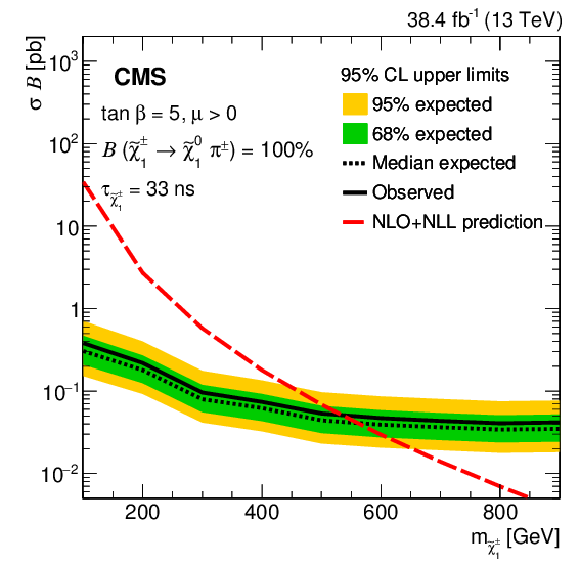
png pdf root |
Figure 3-c:
The expected and observed 95% CL upper limits on the product of the cross section for direct production of charginos and their branching fraction to $ {\tilde{\chi}^{0}_{1}} {\pi ^\mathrm {{\pm}}}$ as a function of chargino mass for chargino lifetime of 1000 cm/$c$. The direct chargino production cross section includes both $ {\tilde{\chi}^{0}_{1}} {\tilde{\chi}^\pm _{1}} $ and $ {\tilde{\chi}^\pm _{1}} {\tilde{\chi}^\mp _{1}} $ production in roughly a 2:1 ratio for all chargino masses considered. The dashed red line indicates the theoretical prediction for the AMSB model. |
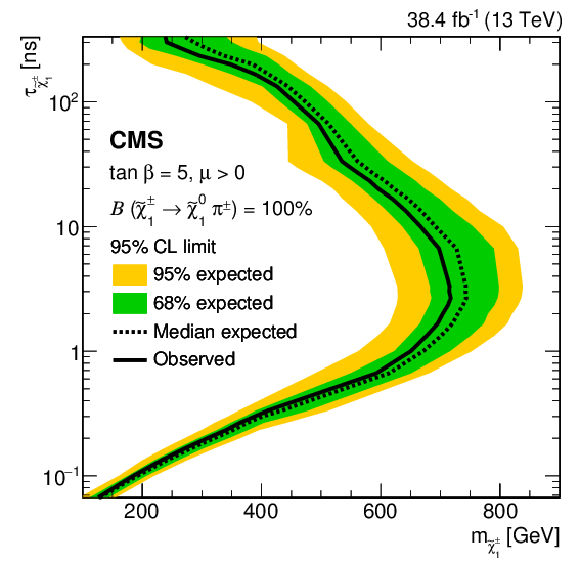
png pdf root |
Figure 4:
The expected and observed constraints on chargino lifetime and mass. The region to the left of the curve is excluded at 95% CL. |
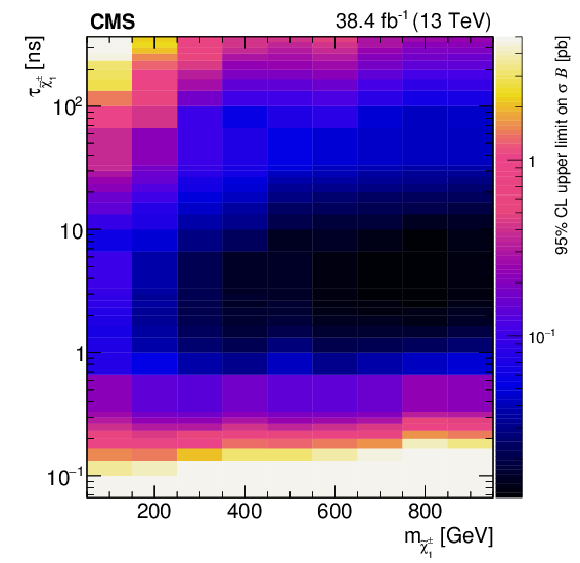
png pdf root |
Figure 5:
The observed 95% CL upper limits on the product of the cross section for direct production of charginos and their branching fraction to $ {\tilde{\chi}^{0}_{1}} {\pi ^\mathrm {{\pm}}}$ as a function of chargino mass and lifetime. The direct chargino production cross section includes both $ {\tilde{\chi}^{0}_{1}} {\tilde{\chi}^\pm _{1}} $ and $ {\tilde{\chi}^\pm _{1}} {\tilde{\chi}^\mp _{1}} $ production in roughly a 2:1 ratio for all chargino masses considered. |
| Tables | |

png pdf |
Table 1:
The data-taking periods and the corresponding integrated luminosities. |
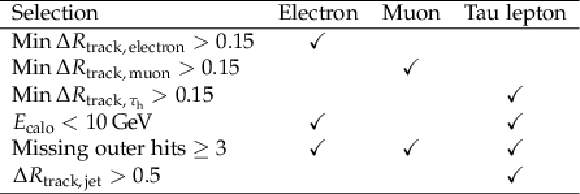
png pdf |
Table 2:
Definitions of the lepton vetoes used in the T&P studies to estimate $ {P_{\text {veto}}} $, for each flavor of charged lepton. The criteria listed are the subset of the search criteria that are the most efficient at rejecting each flavor. |
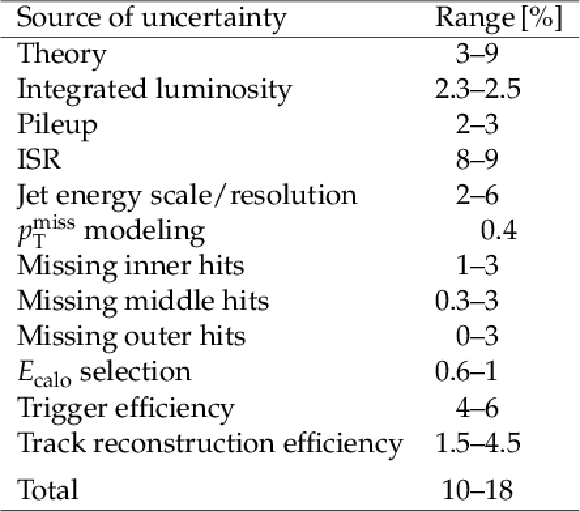
png pdf |
Table 3:
Summary of the systematic uncertainties in the signal yields. The ranges represent either the variation with chargino mass and lifetime or with the data-taking period used to calculate the uncertainty, depending on the source of each uncertainty as described in the text. |

png pdf |
Table 4:
Summary of numbers of events for the estimated backgrounds and the observed data. The uncertainties include those from statistical and systematic sources. In categories where the systematic uncertainty is negligible, it is not shown. |
| Summary |
| A search has been presented for long-lived charged particles that decay within the CMS detector and produce the signature of a disappearing track. In a sample of proton-proton data recorded in 2015 and 2016 at a center-of-mass energy of 13 TeV and corresponding to an integrated luminosity of 38.4 fb$^{-1}$, seven events are observed, compared with the estimated background from standard model processes of 6.5 $\pm$ 0.9 (stat) $\pm$ 1.0 (syst) events. The observation is consistent with the background-only hypothesis. The results are interpreted in the context of the anomaly-mediated supersymmetry breaking model, which predicts a small mass difference between the lightest chargino ($\tilde{\chi}^{\pm}_1$) and neutralino ($\tilde{\chi}^0_1$). The chargino decays via $\tilde{\chi}^{\pm}_1 \to \tilde{\chi}^0_1 \pi^{\pm}$, and because of the limited phase space available for the decay, the chargino has a lifetime on the order of 1 ns and the pion generally has too low momentum to yield a reconstructed track. If the chargino decays inside the tracker volume, it can thus produce a disappearing track. We place constraints on the mass of charginos from direct electroweak production, for chargino mean proper lifetimes between 0.1 and 100 ns. Charginos with masses up to 715 (695) GeV for a lifetime of 3 (7) ns are excluded at 95% confidence level, as are charginos with lifetimes from 0.5 to 60 ns for a mass of 505 GeV. These constraints extend the limits set by a previous search for disappearing tracks performed by the CMS Collaboration [12] and are complementary to the limits set by searches for heavy stable charged particles, which exclude charginos with much longer lifetimes [15,16]. For chargino lifetimes above $\approx$0.7 ns, the present search places the most stringent constraints using a disappearing track signature on direct chargino production. |
| Additional Tables | |
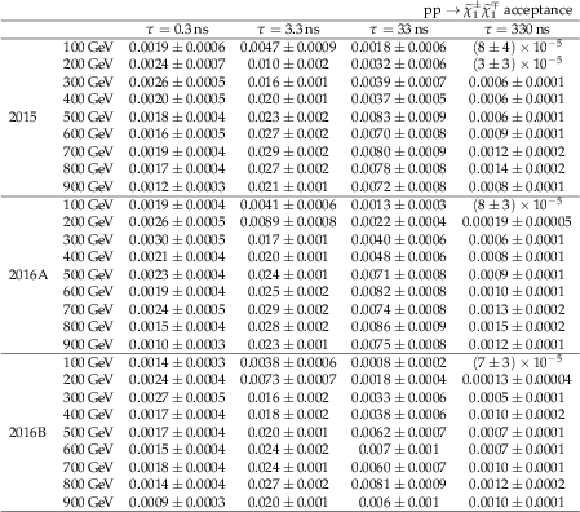
png pdf |
Additional Table 1:
Signal acceptance for each of the generated chargino masses and lifetimes for $ {\mathrm {p}} {\mathrm {p}}\to {\tilde{\chi}^\pm _{1}} \tilde{\chi}^\mp _{1}$ events. The acceptances corresponding to the 2015, 2016A, and 2016B data-taking periods are shown separately. The uncertainties shown include only the statistical uncertainty resulting from the limited sizes of the generated samples. |

png pdf |
Additional Table 2:
Signal acceptance for each of the generated chargino masses and lifetimes for $ {\mathrm {p}} {\mathrm {p}}\to {\tilde{\chi}^\pm _{1}} {\tilde{\chi}^{0}_{1}} $ events. The acceptances corresponding to the 2015, 2016A, and 2016B data-taking periods are shown separately. The uncertainties shown include only the statistical uncertainty resulting from the limited sizes of the generated samples. |

png pdf |
Additional Table 3:
Predicted signal yields for the 2015 data-taking period after the application of each of the disappearing track selections for three chargino lifetime hypotheses ($\tau = $ 0.3, 3.3, and 33 ns) with a chargino mass of 700 GeV. The selections listed are cumulative, i.e., only the events and objects passing a given selection are considered in subsequent selections. The uncertainties shown include only the statistical uncertainty resulting from the limited sizes of the generated samples. |
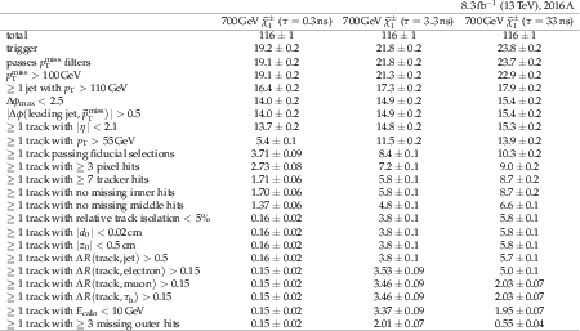
png pdf |
Additional Table 4:
Predicted signal yields for the 2016A data-taking period after the application of each of the disappearing track selections for three chargino lifetime hypotheses ($\tau = $ 0.3, 3.3, and 33 ns) with a chargino mass of 700 GeV. The selections listed are cumulative, i.e., only the events and objects passing a given selection are considered in subsequent selections. The uncertainties shown include only the statistical uncertainty resulting from the limited sizes of the generated samples. |

png pdf |
Additional Table 5:
Predicted signal yields for the 2016B data-taking period after the application of each of the disappearing track selections for three chargino lifetime hypotheses ($\tau = $ 0.3, 3.3, and 33 ns) with a chargino mass of 700 GeV. The selections listed are cumulative, i.e., only the events and objects passing a given selection are considered in subsequent selections. The uncertainties shown include only the statistical uncertainty resulting from the limited sizes of the generated samples. |
| References | ||||
| 1 | G. F. Giudice, M. A. Luty, H. Murayama, and R. Rattazzi | Gaugino mass without singlets | JHEP 12 (1998) 027 | hep-ph/9810442 |
| 2 | L. Randall and R. Sundrum | Out of this world supersymmetry breaking | NPB 557 (1999) 79 | hep-th/9810155 |
| 3 | C. H. Chen, M. Drees, and J. F. Gunion | A nonstandard string / SUSY scenario and its phenomenological implications | PRD 55 (1997) 330 | hep-ph/9607421 |
| 4 | H.-C. Cheng, B. A. Dobrescu, and K. T. Matchev | Generic and chiral extensions of the supersymmetric standard model | NPB 543 (1999) 47 | hep-ph/9811316 |
| 5 | T. Gherghetta, G. F. Giudice, and J. D. Wells | Phenomenological consequences of supersymmetry with anomaly induced masses | NPB 559 (1999) 27 | hep-ph/9904378 |
| 6 | J. L. Feng et al. | Discovering supersymmetry at the Tevatron in wino LSP scenarios | PRL 83 (1999) 1731 | hep-ph/9904250 |
| 7 | M. Ibe, S. Matsumoto, and T. T. Yanagida | Pure gravity mediation with $ m_{3/2} = $ 10 -- 100 TeV | PRD 85 (2012) 095011 | 1202.2253 |
| 8 | L. J. Hall, Y. Nomura, and S. Shirai | Spread supersymmetry with wino LSP: gluino and dark matter signals | JHEP 01 (2013) 036 | 1210.2395 |
| 9 | A. Arvanitaki, N. Craig, S. Dimopoulos, and G. Villadoro | Mini-split | JHEP 02 (2013) 126 | 1210.0555 |
| 10 | N. Arkani-Hamed et al. | Simply unnatural supersymmetry | 1212.6971 | |
| 11 | M. Citron et al. | End of the CMSSM coannihilation strip is nigh | PRD 87 (2013) 036012 | 1212.2886 |
| 12 | CMS Collaboration | Search for disappearing tracks in proton-proton collisions at $ \sqrt{s}= $ 8 TeV | JHEP 01 (2015) 096 | CMS-EXO-12-034 1411.6006 |
| 13 | ATLAS Collaboration | Search for charginos nearly mass degenerate with the lightest neutralino based on a disappearing-track signature in pp collisions at $ \sqrt{s} = $ 8 TeV with the ATLAS detector | PRD 88 (2013) 112006 | 1310.3675 |
| 14 | ATLAS Collaboration | Search for long-lived charginos based on a disappearing-track signature in pp collisions at $ \sqrt{s} = $ 13 TeV with the ATLAS detector | Submitted to \it JHEP | 1712.02118 |
| 15 | CMS Collaboration | Searches for long-lived charged particles in pp collisions at $ \sqrt{s} = $ 7 and 8 TeV | JHEP 07 (2013) 122 | CMS-EXO-12-026 1305.0491 |
| 16 | CMS Collaboration | Constraints on the pMSSM, AMSB model and on other models from the search for long-lived charged particles in proton-proton collisions at $ \sqrt{s} = $ 8 TeV | EPJC 75 (2015) 325 | CMS-EXO-13-006 1502.02522 |
| 17 | CMS Collaboration | Description and performance of track and primary-vertex reconstruction with the CMS tracker | JINST 9 (2014) P10009 | CMS-TRK-11-001 1405.6569 |
| 18 | CMS Collaboration | The CMS trigger system | JINST 12 (2017) P01020 | CMS-TRG-12-001 1609.02366 |
| 19 | CMS Collaboration | The CMS experiment at the CERN LHC | JINST 3 (2008) S08004 | CMS-00-001 |
| 20 | CMS Collaboration | CMS luminosity measurement for the 2015 data taking period | CMS-PAS-LUM-15-001 | CMS-PAS-LUM-15-001 |
| 21 | CMS Collaboration | CMS luminosity measurements for the 2016 data taking period | CMS-PAS-LUM-17-001 | CMS-PAS-LUM-17-001 |
| 22 | T. Sjostrand, S. Mrenna, and P. Z. Skands | PYTHIA 6.4 physics and manual | JHEP 05 (2006) 026 | hep-ph/0603175 |
| 23 | J. Pumplin et al. | New generation of parton distributions with uncertainties from global QCD analysis | JHEP 07 (2002) 012 | hep-ph/0201195 |
| 24 | F. E. Paige, S. D. Protopopescu, H. Baer, and X. Tata | ISAJET 7.69: A Monte Carlo event generator for pp, $ \overline{\mathrm{p}}\mathrm{p} $, and $ \mathrm{e}^+ \mathrm{e}^- $ reactions | hep-ph/0312045 | |
| 25 | M. Ibe, S. Matsumoto, and R. Sato | Mass splitting between charged and neutral winos at two-loop level | PLB 721 (2013) 252 | 1212.5989 |
| 26 | B. Fuks, M. Klasen, D. R. Lamprea, and M. Rothering | Gaugino production in proton-proton collisions at a center-of-mass energy of 8 TeV | JHEP 10 (2012) 081 | 1207.2159 |
| 27 | B. Fuks, M. Klasen, D. R. Lamprea, and M. Rothering | Precision predictions for electroweak superpartner production at hadron colliders with resummino | EPJC 73 (2013) 2480 | 1304.0790 |
| 28 | P. M. Nadolsky et al. | Implications of CTEQ global analysis for collider observables | PRD 78 (2008) 013004 | 0802.0007 |
| 29 | A. D. Martin, W. J. Stirling, R. S. Thorne, and G. Watt | Parton distributions for the LHC | EPJC 63 (2009) 189 | 0901.0002 |
| 30 | J. Butterworth et al. | PDF4LHC recommendations for LHC Run II | JPG 43 (2016) 023001 | 1510.03865 |
| 31 | CMS Collaboration | Search for top-squark pair production in the single-lepton final state in pp collisions at $ \sqrt{s} = $ 8 TeV | EPJC 73 (2013) 2677 | CMS-SUS-13-011 1308.1586 |
| 32 | J. Alwall et al. | The automated computation of tree-level and next-to-leading order differential cross sections, and their matching to parton shower simulations | JHEP 07 (2014) 079 | 1405.0301 |
| 33 | T. Sjostrand, S. Mrenna, and P. Z. Skands | A brief introduction to PYTHIA 8.1 | CPC 178 (2008) 852 | 0710.3820 |
| 34 | P. Nason | A new method for combining NLO QCD with shower Monte Carlo algorithms | JHEP 11 (2004) 040 | hep-ph/0409146 |
| 35 | S. Frixione, P. Nason, and C. Oleari | Matching NLO QCD computations with parton shower simulations: the POWHEG method | JHEP 11 (2007) 070 | 0709.2092 |
| 36 | S. Alioli, P. Nason, C. Oleari, and E. Re | A general framework for implementing NLO calculations in shower Monte Carlo programs: the POWHEG BOX | JHEP 06 (2010) 043 | 1002.2581 |
| 37 | T. Melia, P. Nason, R. Rontsch, and G. Zanderighi | $ \text{W}^{+}\text{W}^{-} $, WZ and ZZ production in the POWHEG BOX | JHEP 11 (2011) 078 | 1107.5051 |
| 38 | P. Nason and G. Zanderighi | W$ ^+ $W$ ^- $, WZ and ZZ production in the POWHEG-BOX-V2 | EPJC 74 (2014) 2702 | 1311.1365 |
| 39 | S. Frixione, P. Nason, and G. Ridolfi | A positive-weight next-to-leading-order Monte Carlo for heavy flavour hadroproduction | JHEP 09 (2007) 126 | 0707.3088 |
| 40 | E. Re | Single-top Wt-channel production matched with parton showers using the POWHEG method | EPJC 71 (2011) 1547 | 1009.2450 |
| 41 | NNPDF Collaboration | Parton distributions for the LHC Run II | JHEP 04 (2015) 040 | 1410.8849 |
| 42 | P. Skands, S. Carrazza, and J. Rojo | Tuning PYTHIA 8.1: the Monash 2013 tune | EPJC 74 (2014) 3024 | 1404.5630 |
| 43 | CMS Collaboration | Event generator tunes obtained from underlying event and multiparton scattering measurements | EPJC 76 (2016) 155 | CMS-GEN-14-001 1512.00815 |
| 44 | S. Agostinelli et al. | GEANT4--a simulation toolkit | NIMA 506 (2003) 250 | |
| 45 | CMS Collaboration | Particle-flow reconstruction and global event description with the CMS detector | JINST 12 (2017) P10003 | CMS-PRF-14-001 1706.04965 |
| 46 | M. Cacciari, G. P. Salam, and G. Soyez | FastJet user manual | EPJC 72 (2012) 1896 | 1111.6097 |
| 47 | M. Cacciari, G. P. Salam, and G. Soyez | The anti-$ {k_{\mathrm{T}}} $ jet clustering algorithm | JHEP 04 (2008) 063 | 0802.1189 |
| 48 | CMS Collaboration | Jet algorithms performance in 13 TeV data | CMS-PAS-JME-16-003 | CMS-PAS-JME-16-003 |
| 49 | CMS Collaboration | Technical proposal for the Phase-II upgrade of the Compact Muon Solenoid | CMS-PAS-TDR-15-002 | CMS-PAS-TDR-15-002 |
| 50 | CMS Collaboration | Measurements of inclusive W and Z cross sections in pp collisions at $ \sqrt{s}= $ 7 TeV | JHEP 01 (2011) 080 | CMS-EWK-10-002 1012.2466 |
| 51 | Particle Data Group Collaboration | Review of particle physics | CPC 40 (2016) 100001 | |
| 52 | R. D. Cousins and V. L. Highland | Incorporating systematic uncertainties into an upper limit | NIMA 320 (1992) 331 | |
| 53 | The ATLAS Collaboration, The CMS Collaboration, The LHC Higgs Combination Group | Procedure for the LHC Higgs boson search combination in summer 2011 | CMS-NOTE-2011-005 | |
| 54 | T. Junk | Confidence level computation for combining searches with small statistics | NIMA 434 (1999) 435 | hep-ex/9902006 |
| 55 | A. L. Read | Presentation of search results: The CL$ _{\text{s}} $ technique | JPG 28 (2002) 2693 | |
| 56 | G. Cowan, K. Cranmer, E. Gross, and O. Vitells | Asymptotic formulae for likelihood-based tests of new physics | EPJC 71 (2011) 1554 | 1007.1727 |

|
Compact Muon Solenoid LHC, CERN |

|

|

|

|

|

|